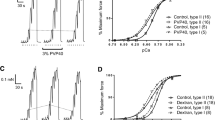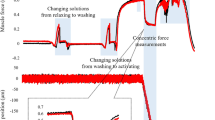Abstract
The goal of this study was to characterize the interrelationship between sarcomere length and interfilament spacing in the control of Ca2+ sensitivity in skinned rabbit psoas muscle fibers. Measurements were made at sarcomere lengths 2.0, 2.7 and 3.4 μm. At 2.7 μm the fiber width was reduced by 17% relative to that at 2.0 μm and the pCa50 for force development was increased by ∼0.3 pCa units. In the presence of 5% Dextran T-500 the fiber width at sarcomere length 2.0 μm was also decreased by 17% and the Ca2+ sensitivity was increased to the same value as at 2.7 μm. In contrast, at sarcomere length 2.7 μm the addition of as much as 10% Dextran T-500 had no effect on Ca2+ sensitivity. At sarcomere length 3.4 μm there was an additional 7% compression and the Ca2+ sensitivity was increased slightly (∼0.1 pCa units) relative to that at 2.7 μm. However at 3.4 μm the addition of 5% Dextran T-500 caused the Ca2+ sensitivity to decrease to the level seen at 2.0 μm. Given that the skinning process causes a swelling of the filament lattice it is evident that the relationship between sarcomere length and Ca2+ sensitivity observed in skinned fibers may not always be applicable to intact fibers. These data are consistent with measurements of Ca2+ in intact fibers which indicate that there might be a decline in Ca2+ sensitivity at long sarcomere lengths.
Similar content being viewed by others
References
Adhikari BB and Fajer PG (1996) Myosin head orientation and mobility during isometric contraction: effects of osmotic compression. Biophys J 70: 1872–1880.
Allen DG and Kentish JC (1985) The cellular basis of the length-tension relation in cardiac muscle. J Mol Cell Cardiol 17: 821–840.
Allen DG and Kentish JC (1988) Calcium concentration in the myoplasm of skinned ferret ventricular muscle following changes in muscle length. J Physiol 407: 489–503.
Allen JD and Moss RL (1987) Factors influencing the ascending limb of the sarcomere length-tension relationship in rabbit skinned muscle fibres. J Physiol 390: 119–136.
April EW and Maughan DW (1986) Active force as a function of filament spacing in crayfish skinned muscle fibers. Pflugers Arch 407: 456–460.
Bagni MA, Cecchi G and Colomo F (1990) Myofilament spacing and force generation in intact frog muscle fibres. J Physiol 430: 61–75.
Balnave CD and Allen DG (1996) The effect of muscle length on intracellular calcium and force in single fibres from mouse skeletal muscle. J Physiol 492: 705–713.
Bremel RD and Weber A (1972) Cooperation within actin filament in vertebrate skeletal muscle. Nature New Biol 238: 97–101.
Calaghan SC and White E (1999) The role of calcium in the response of cardiac muscle to stretch. Prog Biophys Mol Biol 71: 59–90.
Claflin DR, Morgan DL and Julian FJ (1998) The effect of length on the relation between tension and intracellular [Ca2+] in intact frog skeletal muscle fibres. J Physiol 508: 179–186.
De Beer EL, Grundeman RLF, Wilhelm AJ, Van Den Berg C, Caljouw CJ, Klepper D and Schierick P (1988) Effect of sarcomere length and filament lattice spacing on force development in skinned cardiac and skeletal muscle. Basic Res Cardiol 83: 410–423.
Endo M (1972) Stretched-induced increase in activation of skinned muscle fibres by calcium. Nature New Biol 237: 211–213.
Fabiato A and Fabiato F (1978) Myofilament-generated tension oscillations during partial calcium activation and activation dependence of the sarcomere length-tension relation in skinned cardiac cells. J Gen Physiol 72: 667–699.
Fabiato A and Fabiato F (1979) Calculator programs for computing the composition of solutions containing multiple metals and ligands used for experiments in skinned muscle cells. J Physiol Paris 75: 463–505.
Fuchs F and Fox C (1982) Parallel measurements of bound calcium and force in glycerinated rabbit psoas muscle fibers. Biochim Biophys Acta 679: 110–115.
Fuchs F (1985) The binding of calcium to detergent-extracted rabbit psoas muscle fibres during relaxation and force generation. J Muscle Res Cell Motil 6: 477–486.
Fuchs F and Wang Y-P (1991) Force, length and Ca2+-troponin C affinity in skeletal muscle. Am J Physiol 261: C787-C792.
Fuchs F and Wang Y-P (1996) Sarcomere length versus interfilament spacing as determinants of cardiac myofilament Ca2+ sensitivity and Ca2+ binding. J Mol Cell Cardiol 28: 1375–1383.
Godt RE and Maughan DW (1977) Swelling of skinned muscle fibers of the frog. Biophys J 19: 103–116.
Godt RE and Maughan DW (1981) Influence of osmotic compression on calcium activation and tension in skinned muscle fibers of the rabbit. Pflugers Arch 391: 334–337.
Gordon AM, Huxley AF and Julian FJ (1966) The variation of isometric tension with sarcomere length in vertebrate muscle fibres. J Physiol 184: 170–192.
Harrison SM, Lamont C and Miller DJ (1988) Hysteresis and length dependence of calcium sensitivity in chemically skinned rat cardiac muscle. J Physiol 401: 115–143.
Hofmann PA and Fuchs F (1987a) The effect of length and cross-bridge attachment on Ca2+ binding to cardiac troponin C. Am J Physiol 253: C90-C96.
Hofmann PA and Fuchs F (1987b) Evidence for a force-dependent component of calcium binding to cardiac troponin C. Am J Physiol 253: C541-C546.
Kawai M, Wray JS and Zhao Y (1993) The effect of lattice spacing change on cross-bridge kinetics in chemically skinned rabbit psoas muscle fibers. I. proportionality between the lattice spacing and the fiber width. Biophys J 64: 187–196.
Kentish JC and Wrzosek A (1998) Changes in force and cytosolic Ca2+ concentration after length changes in isolated rat ventricular trabeculae. J Physiol 506: 431–444.
Komukai K and Kurihara S (1997) Length dependence of Ca2+-tension relationship in aequorin-injected ferret papillary muscles. Am J Physiol 273: H1068-H1074.
Krasner B and Maughan DW (1984) The relationship between ATP hydrolysis and active force in compressed and swollen skinned muscle fibers of the rabbit. Pflugers Arch 400: 160–165.
Lehrer SS (1994) The regulatory switch of the muscle thin filament: Ca2+ or myosin heads? J Muscle Res Cell Motil 15: 232–236.
Magid A and Reedy MK (1980) X-ray diffraction observations of chemically skinned frog skeletal muscle processed by an improved method. Biophys J 30: 27–40.
Martyn DA and Gordon AM (1988) Length and myofilament spacing-dependent changes in calcium sensitivity of skeletal fibres: effects of pH and ionic strength. J Muscle Res Cell Motil 9: 428–445.
McDonald KS and Moss RL (1995) Osmotic compression of single cardiac myocytes eliminates the reduction in Ca2+ sensitivity of tension at short sarcomere length. Circ Res 77: 199–205.
Millman BM (1998) The filament lattice of striated muscle. Physiol Rev 78: 359–391.
Moisescu DG and Thieleczek R (1979) Sarcomere length effects on the Sr2+ and Ca2+-activation curves in skinned frog muscle fibers. Biochim Biophys Acta 546: 64–76.
Patel JR, McDonald KS, Wolff MR and Moss RL (1997) Ca2+ binding to troponin C in skinned skeletal muscle fibers assessed with caged Ca2+ and a Ca2+ fluophore: invariance of Ca2+ binding as a function of sarcomere length. J Biol Chem 272: 6018–6027.
Rassier DE, MacIntosh BR and Herzog W (1999) Length dependence of active force production in skeletal muscle. J Appl Physiol 86: 1445–1457.
Stienen GJM, Blange T and Treijtel BW (1985) Tension development and calcium sensitivity in skinned muscle fibers of the frog. Pflugers Archiv 405: 19–23.
Stephenson DG and Williams DA (1982) Effects of sarcomere length on the force-pCa relation in fast-and slow-twitch skinned muscle fibres from the rat. J Physiol 333: 637–653.
Swartz DR, Moss RL and Greaser ML (1996) Calcium alone does not fully activate the thin filament for S1 binding to rigor myofibrils. Biophys J 71: 1891–1904.
Vibert P, Craig R and Lehman W (1997) Steric model for activation of muscle thin filaments. J Mol Biol 266: 8–14.
Wang Y-P and Fuchs F (1994) Length, force and Ca2+-troponin C affinity in cardiac and slow skeletal muscle. Amer J Physiol 266: C1077-C1082.
Wang Y-P and Fuchs F (1996) Osmotic compression of skinned cardiac and skeletal muscle bundles: effects on force generation, Ca2+ sensitivity and Ca2+ binding. J Mol Cell Cardiol 27: 1235–1244.
Zhao Y and Kawai M (1993) The effect of lattice spacing on cross-bridge kinetics in chemically skinned rabbit psoas muscle fibers. II. elementary steps affected by the spacing change. Biophys J 64: 197–210.
Author information
Authors and Affiliations
Rights and permissions
About this article
Cite this article
Wang, YP., Fuchs, F. Length-dependent effects of osmotic compression on skinned rabbit psoas muscle fibers. J Muscle Res Cell Motil 21, 313–319 (2000). https://doi.org/10.1023/A:1005679215704
Issue Date:
DOI: https://doi.org/10.1023/A:1005679215704




